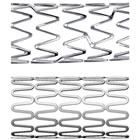
Which stent platform do you think compresses more easily: Boston Scientific’s Element (top) or Medtronic’s Integrity (bottom)?
I first heard concerns about stent deformation, primarily seen in the PROMUS Element stent made by Boston Scientific (NYSE: BSX), during a presentation at a small interventional meeting last summer. The issue was then reported in two journal articles, just prior to the TCT meeting in November, where it became a topic of much attention — although most interventional cardiologists felt that it was nothing like the problem of late stent thrombosis, first seen as a “rare” event in the first generation of drug-eluting stents five years ago. Continue reading

 Forgive the perverse Shakespearean pun in the title but, as the Bard wrote: “What’s in a name? That which we call a rose by any other name would smell as sweet.” My topic is pretty much the polar opposite of roses, but the whole concept of labels and what we call things has become increasingly important. It’s one that I touched on in
Forgive the perverse Shakespearean pun in the title but, as the Bard wrote: “What’s in a name? That which we call a rose by any other name would smell as sweet.” My topic is pretty much the polar opposite of roses, but the whole concept of labels and what we call things has become increasingly important. It’s one that I touched on in  The question of the day, regarding whether or not to stent a coronary artery, is now being brought to the forefront by the U.S. government in the form of a
The question of the day, regarding whether or not to stent a coronary artery, is now being brought to the forefront by the U.S. government in the form of a 
 Call it an accordian, a concertina or a “squeezebox”…but don’t call it a stent. Because one thing that is not music to your ears is a coronary stent that you have carefully placed to relieve your patient’s symptoms — and which then gets shorter or longer when you push or pull another catheter, balloon or wire through it.
Call it an accordian, a concertina or a “squeezebox”…but don’t call it a stent. Because one thing that is not music to your ears is a coronary stent that you have carefully placed to relieve your patient’s symptoms — and which then gets shorter or longer when you push or pull another catheter, balloon or wire through it.

